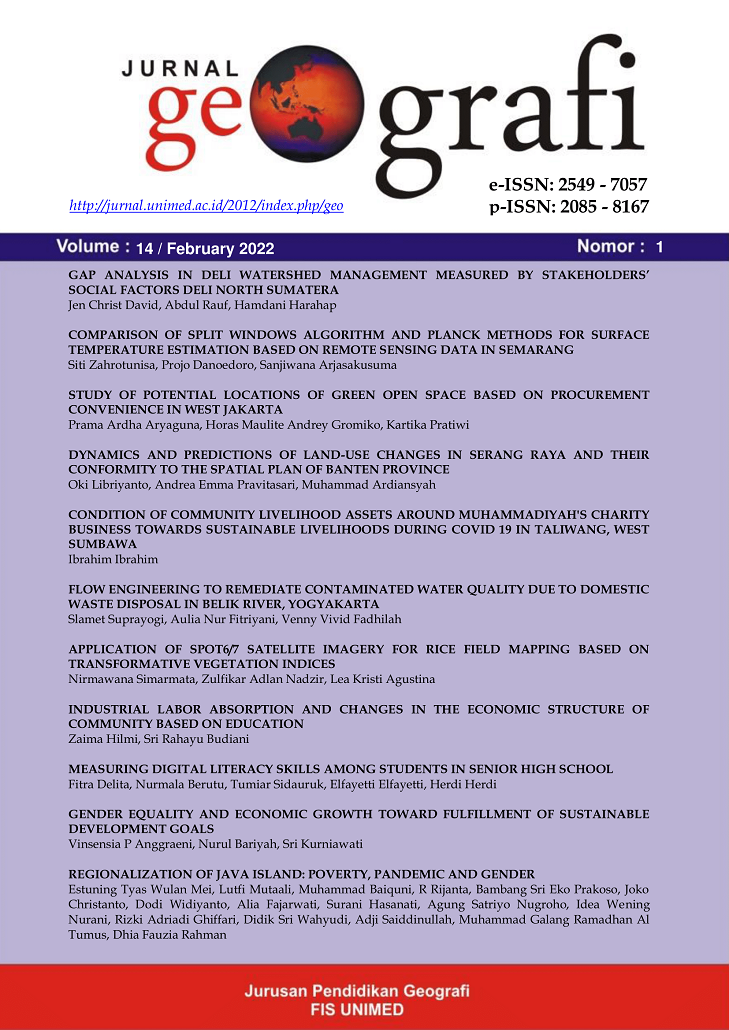MEASURING DIGITAL LITERACY SKILLS AMONG STUDENTS IN SENIOR HIGH SCHOOL
DOI:
https://doi.org/10.24114/jg.v14i1.31234Abstract
Various digital-based learning media strongly support the quality of online learning. Digital media is essential in the learning process because it can package the material into more contextual, interesting audiovisual, reduces verbalism, and is more interactive. The primary purpose of this research was to measure the differences in digital literacy by comparing the digital learning media and PowerPoint media in online learning. The design of this study was a pretest-posttest group with a quasi-experimental method. Overall, 56 students in a senior high school in Senior High School 2 Percut Sei Tuan, Medan City, Sumatera Utara Province, served as participants in this study. Data were collected by questionnaires and structured interviews for digital literacy. Data analyses were mixed with the quantitative and qualitative methods. Quantitative data were analyzed statistically through independent samples t-test, and qualitative data were analyzed descriptively. Digital literacy data were analyzed using SPSS version 24 software. The results showed that the students' digital literacy using digital learning media was superior to those prepared using PowerPoint. Based on each aspect of digital literacy, namely, internet searching, understanding, and utilizing digital devices, hypertextual navigation, content evaluation, creating digital content, and communicating information, there were significant differences between groups on digital literacy competencies. All aspects of digital literacy in the experimental class were higher than in the control classKeywords: Digital Literacy, E-Learning, Learning MediaReferences
Akrim, M. (2018). Media Learning in Digital Era. 231(Amca), 458“460. https://doi.org/10.2991/amca-18.2018.127
Al Khateeb, A. A. M. (2017). Measuring Digital Competence and ICT Literacy: An Exploratory Study of In-Service English Language Teachers in the Context of Saudi Arabia. International Education Studies, 10(12), 38. https://doi.org/10.5539/ies.v10n12p38
Alexander et al. (2016). Living with New Technologies. Scientific American, 273(3), 190“205. https://doi.org/10.1038/scientificamerican0995-190
Berutu, N., Delita, F., Astuti, A. J. D., Novira, N., & Wirda, M. A. (2019). The Strategy to Strengthen Information Literacy Based on Library and Digital Resources. 208(ICSSIS 2018). https://doi.org/10.2991/icssis-18.2019.28
Bond, M., MarÃn, V. I., Dolch, C., Bedenlier, S., & Zawacki-Richter, O. (2018). Digital transformation in German higher education: student and teacher perceptions and usage of digital media. International Journal of Educational Technology in Higher Education, 15(1), 1“20. https://doi.org/10.1186/s41239-018-0130-1
Buckingham, D. (2010). Defining Digital Literacy. Medienbildung in Neuen Kulturräumen, 1, 59“71. https://doi.org/10.1007/978-3-531-92133-4_4
Commission, E. (2019). Eurydice 2019:Digital Education at School in Europe. In © Education, Audiovisual and Culture Executive Agency, 2019. https://doi.org/10.2797/763
Delita, F. (2021). The Challenges of E-Learning Implementation During the Covid-19 Pandemic in Senior High School. Journal of Digital Learning and Education, 1(3), 150“157. https://doi.org/10.52562/jdle.v1i3.257
Falloon, G. (2020). From digital literacy to digital competence: the teacher digital competency (TDC) framework. Educational Technology Research and Development, 68(5), 2449“2472. https://doi.org/10.1007/s11423-020-09767-4
Kamaluddin, M., & Widjajanti, D. B. (2019). The Impact of Discovery Learning on Students™ Mathematics Learning Outcomes. Journal of Physics: Conference Series, 1320(1), 709“722. https://doi.org/10.1088/1742-6596/1320/1/012038
Law, N., Woo, D., de la Torre, J., & Wong, G. (2018). A Global Framework of Reference on Digital Literacy. UNESCO Institute for Statistics, 51, 146.
Leach, A. M. (2017). Digital Media Production to Support Literacy for Secondary Students with Diverse Learning Abilities. Journal of Media Literacy Education, 9(2), 30“44. https://doi.org/10.23860/jmle-2019-09-02-03
Liza, K., & Andriyanti, E. (2020). Digital literacy scale of English pre-service teachers and their perceived readiness toward the application of digital technologies. Journal of Education and Learning (EduLearn), 14(1), 74“79. https://doi.org/10.11591/edulearn.v14i1.13925
Nelson, K., Courier, M., & Joseph, G. (2011). An Investigation of Digital Literacy Needs of Students. Journal of Information Systems Education, 22(2), 95“109.
Oh, S. S., Kim, K. A., Kim, M., Oh, J., Chu, S. H., & Choi, J. Y. (2021). Measurement of digital literacy among older adults: Systematic review. Journal of Medical Internet Research, 23(2). https://doi.org/10.2196/26145
Paidi, Subali, B., & Handoyo, L. D. (2021). The mastery of technological, pedagogical, and content knowledge among Indonesian biology teachers. European Journal of Educational Research, 10(3), 1063“1073. https://doi.org/10.12973/EU-JER.10.3.1063
Perdana, R., Riwayani, R., Jumadi, J., & Rosana, D. (2019). Web-Based Simulation on Physics Learning to Enhance Digital Literacy Skill of High School Students. JIPF (Jurnal Ilmu Pendidikan Fisika), 4(2), 70. https://doi.org/10.26737/jipf.v4i2.1048
Perdana, R., Yani, R., Jumadi, J., & Rosana, D. (2019). Assessing Students™ Digital Literacy Skill in Senior High School Yogyakarta. JPI (Jurnal Pendidikan Indonesia), 8(2), 169. https://doi.org/10.23887/jpi-undiksha.v8i2.17168
Pinto da Mota Matos, A., Isabel Festas, M., & Maria Seixas, A. (2016). Digital media and the challenges for media education. Applied Technologies and Innovations, 12(2), 43“53. https://doi.org/10.15208/ati.2016.04
Purwadi et al. (2020). The Effect of Smartphones Usability on High School Students™ Science Literacy Ability in Physics Learning. European Journal of Educational Research, 9(3), 1257“1265.
Puspita Sari, A., & Setiawan, A. (2018). The Development of Internet-Based Economic Learning Media using Moodle Approach. International Journal of Active Learning, 3(2), 100“109. http://journal.unnes.ac.id/nju/index.php/ijal
Rusydiyah, E. F., Purwati, E., & Prabowo, A. (2020). How to use digital literacy as a learning resource for teacher candidates in Indonesia. Cakrawala Pendidikan, 39(2), 305“318. https://doi.org/10.21831/cp.v39i2.30551
Sagitaa, D. D., Asni, Nofriza, F., Fitniwilis, burhendi, F. C. A., & Siswanto, R. D. (2019). Students™ digital literacy skill to solve learning problems. International Journal of Innovation, Creativity and Change, 5(6), 112“122.
Sanchez-Prieto, J., Trujillo-Torres, J. M., Gómez-GarcÃa, M., & Gómez-GarcÃa, G. (2020). The generational digital gap within dual vocational education and training teachers. European Journal of Educational Research, 9(4), 1557“1567. https://doi.org/10.12973/EU-JER.9.4.1557
Sharma, M. M. M. (2017). Teacher in a Digital Era. Global Journal of Computer Science and Technology, 17(3), 11“14.
Sidauruk, T., Delita, F., Berutu, N., Elfayetti, E., & Yenny, N. (2021). The Effect of E-Learning on the Student™s Learning Outcome in Higher Education. 2“5. https://doi.org/10.4108/eai.31-8-2021.2313756
UNESCO. (2019). Recommendations on Assessment Tools for Monitoring Digital Literacy within UNESCO Digital Literacy Global Framework. Information Paper, 56, 23.
Yustika, G. P., & Iswati, S. (2020). Digital Literacy in Formal Online Education: A Short Review. Dinamika Pendidikan, 15(1), 66“76. https://doi.org/10.15294/dp.v15i1.23779







